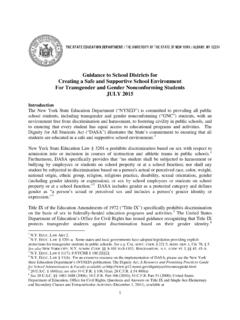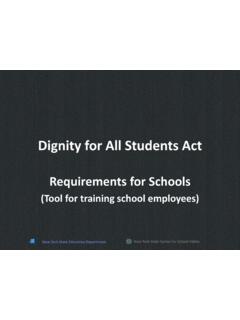Transcription of THE DIGNITY FOR ALL STUDENTS ACT: A QUANTITATIVE …
1 1 THE DIGNITY FOR ALL STUDENTS ACT: A QUANTITATIVE STUDY OF ONE UPSTATE NEW YORK PUBLIC SCHOOL IMPLEMENTATION By Christopher M. Riddell A doctoral dissertation Presented to the Graduate Faculty of the Doctor of Law and Policy Program at Northeastern University In partial fulfillment of the requirements for the degree of Doctor of Law and Policy Under the supervision of Dr. Monica Savoy College of Professional Studies Northeastern University Boston, Massachusetts June 2018 2 Christopher M. Riddell, 2018 3 Acknowledgements Many thanks go to my best friend, Dr. Howard Feldman, without his help not only in proofing many papers but moral support the journey, would have been harder. I would also like to thank my committee members, Dr. Monica Savoy and Dr. Matthew Hawes, I learned from each of them. I would be remised if I did not acknowledge Dr. Pawlyshyn s guidance, she is a gem. And to my son Justin who knew just what music to play for me after a long day.
2 4 Abstract This QUANTITATIVE study uses a survey to determine how public school teachers perceive the efficacy of the intervention of the DIGNITY For All Student s Act on the climate of civility in the classroom at one specific public middle school located in Upstate New York. The intent is to explore the perceived efficacy of the intervention put into place in 2012 to address cyberharassment and to cultivate civility in the classroom. A total of 47 teachers participated in this study. This study provides background on the prevalence of cyberharassment in schools. The results show that the cyberharassment behaviors of sexting, stalking, bullying, spreading rumors, and sending embarassing pictures have occurred with some frequency over the 2017-2018 school year. Sexting was the most witnessed by teachers ( percent) with percent indicating a frequency of once a year. The sending of pictures to embarrass was observed by percent of the teachers, percent observed the frequency of once a month.
3 The spreading sexual rumors was observed by percent of the teachers with a frequency of percent stating it occurs once a week. The findings further suggest an inconsistency among teachers in addressing online behavior with their STUDENTS . Some teachers (38 percent) indicated they discuss appropriate online behavior with their STUDENTS as needed, while 29 percent indicate they never do. Additionally, percent view the DIGNITY For All STUDENTS Act as having an average effect on cultivating civility as a part of the school s culture. Additionally, percent of the respondents believe dasa has had little impact on cyberharassment incidents. Keywords: DIGNITY , cyberharassment, bullying, civility, culture. 5 Table of Contents Acknowledgements .. 3 Abstract .. 4 Table of Contents .. 5 List of Tables .. 9 List of Figures .. 10 Chapter 1: Introduction and Background .. 11 Law and Policy Review .. 16 Description and Opposition to dasa .
4 18 Title IX and Landmark Cases .. 19 Second Circuit Cases and Title IX .. 22 Wisniewski v. Board of Education of the Weedsport Central School District .. 22 People v. Marquan M .. 23 v. Bellmore-Merrick Central High School District .. 25 Problem Statement .. 26 Purpose Statement .. 26 Research Questions and Hypothesis .. 27 Theoretical Framework .. 29 32 Cyberharassment .. 32 Cyberbullying.. 32 Sexting.. 32 6 Cyberstalking.. 33 Assumptions .. 33 Scope and Delimitations .. 33 Limitations of This Study .. 34 Significance of This Research .. 34 Summary .. 35 Chapter 2: Literature Review .. 37 Literature Search 37 Literature Review Related to Key Concepts and Variables .. 37 Cyberharassment .. 39 Sexting .. 42 Cyberstalking .. 47 New York State Law .. 49 Summary .. 49 Chapter 3: Research 51 Research Methodology and Rationale .. 51 Positionality Statement .. 52 Population Selection .. 53 Procedures for Recruitment and Participation.
5 54 Instrumentation .. 55 Data Analysis .. 56 Reliability and Threats to Validity .. 57 Ethical Concerns .. 58 7 Conclusion .. 58 Chapter 4: Research Findings .. 59 Survey Respondents Demographic Profile .. 60 Findings .. 61 Summary .. 71 Chapter 5: Discussion of the Research Findings .. 73 Summary of the Research Results .. 73 Discussion of the Research Results .. 75 In Relation to the Theoretical Framework .. 75 In Relation to the Literature .. 78 Limitations of the Study and Impact on Results .. 82 Implications of the Research Findings for Practice .. 83 Implications of the Research Findings for Future Research .. 86 Conclusion .. 89 References .. 91 Appendix A .. 107 Six Sections of dasa .. 107 Section one.. 107 Section two.. 107 Section three.. 107 Section four.. 108 Section five.. 108 Section six.. 108 8 Appendix B .. 109 Second Circuit Title IX Cases .. 109 Appendix C .. 111 dasa Definition: .. 111 Appendix D .. 112 New York State Sexting Statute.
6 112 Appendix E .. 113 Consent Form .. 113 Appendix 115 Survey Instrument .. 115 Appendix G .. 121 Complete List of dasa Instructional Resources .. 121 Appendix H .. 122 Cartoon Illustrated By Student .. 122 Appendix I .. 123 Article Written By Student .. 123 Appendix J .. 124 Question Presented By Parent On Bullying .. 124 Appendix K .. 125 The Determinates for The Three VADIR Categories .. 125 Intimidation, Harassment, Menacing, or Bullying Behavior and No Physical Contact.. 125 9 List of Tables Table 1 Descriptive Statistics of Teachers Tenure at the School 58 Table 2 Descriptive Statistics of Teachers Total Teaching Tenure 59 Table 3 Descriptive Statistics of Cyberharassment Incidents Observed 61 Table 4 Correlation of Teachers View of Cyberharassment as Hurtful 63 Table 5 Correlation of Teachers Opinion of if Cyberharassment is a Serious Problem 64 Table 6 Descriptive Statistics For Reasons Teachers Do Not Consistently Discuss Online Behaviors 65 Table 7 Descriptive Statistics Why dasa Standards Are Not Implemented Into Lesson Plans 65 Table 8 How Effective dasa In Cultivating Civility 68 Table 9 Reasons dasa is Ineffective 68 Table 10 Violent and Disruptive Incident Reporting (VADIR) System 86 10 List of Figures Figure 1 Reasons Why STUDENTS Were Cyberharassed (percent)
7 60 Figure 2 Actions Taken by Teacher s After Witnessing Cyberharassment 62 Figure 3 Frequency In Which Teachers Talk To Their STUDENTS 64 Figure 4 Teachers Most Commonly Used Instructional Resource 66 Figure 5 How Effective dasa In Cultivating Civility 66 Figure 6 Has dasa Impacted the Number of Cyberharassment Incidents 67 11 Chapter 1: Introduction and Background People, as a whole, seem less concerned about the interaction among each other and more concerned toward the self and technology (Peck, 2002). As STUDENTS continue to immerse themselves in online activities and social media, relationships become less important, and courtesies appear to have become non-existent (Wilkins, Caldarella, Crook-Lyon, & Young, 2010). The behaviors expressed online suggest that incivility has increased in schools (Feldman, 2001; Peck, 2002). Cyberharassment is a term that includes an extensive range of disparaging online activities including cyberbullying, stalking, sexual solicitation, pornography, and sexting (Citron, 2014; Bryce, Franqueira, & Marrington, 2016; Nordahl, Beran, & Dittrick, 2013; Smith, 2009).
8 It is the recurrent online behavior that intentionally targets a certain person and causes the individual substantial emotional or bodily harm (Citron, 2014; Hazelwood & Koon-Magnin, 2013). Although STUDENTS partake in sexual solicitation and pornography, this research is limited to policies and laws related to the cyberharassment behaviors of cyberbullying, cyberstalking, and sexting. School bullying became a national concern in 1999 after the Columbine High School shooting, which was perpetrated by vengeful victims of bullying (Cornell & Limber, 2015). Cornell & Limber (2015) and Beran & Lupart (2009) noted STUDENTS should not perceive schools as having an unfriendly environment. However, to children who fall victim to bullying, the playground becomes hostile and unfriendly. The convenience with the prospect of secrecy that technology has can place children at a heightened risk for becoming a victim of cyberharassment (Farrukh, Sadwick, & Villasenor, 2014; Ybarra, 2004).
9 In one study, D Antona, Kevorkian, and Russom (2010) found that of the 835 STUDENTS in grades 3-5, 35 percent had cell phones, percent received emails that were upsetting from peers, and half the STUDENTS responded that they had been a victim of cyberharassment. 12 Moreover, only 12 percent of STUDENTS stated they had someone to talk to about cyberharassment (D Antona et al., 2010). Cyberharassment occurs via web-based and other forms of modern technology (Mishna, McLuckie, & Saini, 2009). In a study by Hinduja & Patchin (2012) of 4,400 11 to 18-year-old STUDENTS , they found more than 20 percent of the STUDENTS indicated they had been a victim of cyberharassment at some point in their life. The Siena College Research Institute (SRI), AT&T, and the Tyler Clementi Foundation (2016) study showed similar findings. In their study of 1,255 Upstate New York STUDENTS and 1,048 online interviews with parents, over one in four (26 percent) STUDENTS in grades 6-12 reported they had been a victim of cyberbullying (p.)
10 3). Moreover, 57 percent of STUDENTS and 53 percent of the parents observed cyberharassment in the form of insulting or threatening comments posted online, pictures meant to embarrass, revealing videos shared online, as well as posted rumors and allegations about sexual activity ( ). Additionally, the Siena et al. (2016) study found that 88 percent of teens spend an hour or more a day on gaming cites, and 80 percent are online an hour or more hanging-out with their friends on social media. Earlier research conducted by Gross (2004) reflects similar results. In his survey of 261 STUDENTS in grades 7-10, he found that STUDENTS spend an average of 40 minutes texting per day. Likewise, research by Kowalski and Limber (2007) reflected comparable results of 3,767 sixth, seventh, and eighth graders as follows: 11 percent reported that they were victims of cyberharassment, and 4 percent reported to have been the aggressor. Siena et al.











